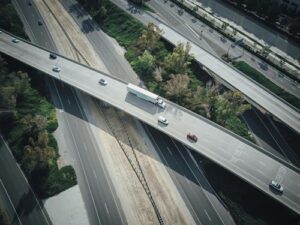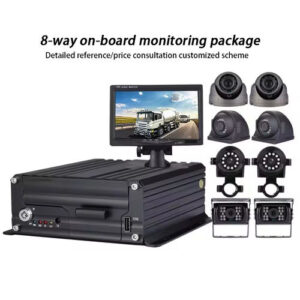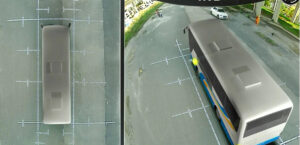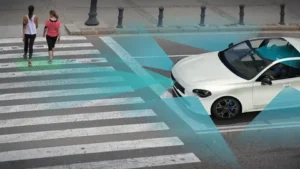AI Camera Monitor Systems are revolutionizing the way we approach surveillance and monitoring. By integrating artificial intelligence with advanced camera technologies, these systems go beyond traditional video recording to offer real-time analytics, predictive insights, and automated responses. This article explores AI camera monitor systems’ features, benefits, applications, and future trends.
What Are AI Camera Monitor Systems?
AI camera monitor systems are surveillance solutions that leverage artificial intelligence to analyze video feeds in real-time. Unlike conventional cameras, which require human operators to review footage, AI systems can automatically detect, identify, and respond to various scenarios. According to Security Magazine, these systems are transforming industries by improving operational efficiency and enhancing safety.
How Do AI Camera Monitor Systems Work?
AI camera monitor systems combine hardware, software, and machine learning algorithms to deliver intelligent surveillance. Here’s how they function:
- Data Capture: Cameras capture high-resolution video feeds, which serve as raw input for analysis.
- AI Processing: Machine learning algorithms analyze the video data to identify patterns, behaviors, and anomalies.
- Real-Time Analytics: The system generates insights and sends alerts based on predefined parameters or detected events.
- Automated Actions: Advanced systems can trigger computerized responses, such as locking doors or alerting authorities.
- Cloud Integration: Video and analytical data are stored in the cloud for easy access and further processing.
Key Features of AI Camera Monitor Systems
Modern AI camera monitor systems offer a range of features that make them indispensable for various applications:
- Facial Recognition: Identifies individuals by analyzing facial features, enhancing access control and security.
- Object Detection: Recognizes and tracks objects such as vehicles, packages, or equipment.
- Behavior Analysis: Detects unusual or suspicious behavior, such as loitering or unauthorized access.
- License Plate Recognition: Reads and records vehicle license plates for traffic monitoring and parking management.
- Real-Time Alerts: Sends instant notifications for events like trespassing, accidents, or equipment malfunctions.
- Cloud-Based Storage: Provides secure and scalable storage for video and analytical data.
- Night Vision: Infrared capabilities allow for effective monitoring in low-light or no-light conditions.
Benefits of AI Camera Monitor Systems
1. Enhanced Security
AI systems proactively identify and respond to potential threats, reducing the risk of security breaches.
2. Operational Efficiency
Automated monitoring eliminates the need for constant human supervision, allowing personnel to focus on higher-priority tasks.
3. Improved Decision-Making
Real-time analytics provide actionable insights, enabling organizations to make data-driven decisions.
4. Cost-Effective
By automating surveillance and reducing manual oversight, AI systems lower operational costs over time.
5. Scalability
Cloud-based solutions make it easy to expand and adapt systems to changing needs, whether adding new cameras or upgrading analytics capabilities.
Applications of AI Camera Monitor Systems
AI camera monitor systems are transforming a wide range of industries, including:
1. Retail
AI systems monitor customer behavior, optimize store layouts, and prevent theft, enhancing both security and sales performance.
2. Healthcare
Hospitals use AI cameras to monitor patient safety, ensure compliance with hygiene protocols, and manage visitor access.
3. Transportation
AI-powered cameras manage traffic flow, detect accidents, and monitor public transit systems for safety and efficiency.
4. Industrial Operations
Factories and warehouses rely on AI systems to monitor machinery, track inventory, and ensure worker safety.
5. Smart Cities
AI cameras play a vital role in urban development by enhancing public safety, managing traffic, and supporting environmental monitoring.
6. Education
Schools and universities use AI systems for access control, attendance tracking, and incident detection, ensuring a secure learning environment.
Advanced Technologies in AI Camera Monitor Systems
The capabilities of AI camera monitor systems are driven by advancements in technology:
1. Deep Learning
Deep learning algorithms enable systems to analyze complex data, improving the accuracy of facial recognition, object detection, and behavior analysis.
2. Edge Computing
Edge computing allows video analysis to occur locally on devices, reducing latency and bandwidth usage.
3. 5G Connectivity
High-speed 5G networks support real-time video streaming and faster data processing for large-scale surveillance systems.
4. IoT Integration
AI cameras are increasingly integrated with IoT devices, creating interconnected ecosystems for smart buildings and cities.
Challenges and Solutions
Despite their advantages, AI camera monitor systems face several challenges:
1. Privacy Concerns
Data collection and analysis raise privacy issues. Adopting encryption and complying with regulations like GDPR can mitigate these concerns.
2. High Initial Costs
Advanced systems can be expensive to implement. However, their long-term savings and scalability make them a worthwhile investment.
3. Technical Limitations
AI systems may struggle in adverse weather conditions or with poor-quality video inputs. Ongoing technological improvements are addressing these issues.
Future Trends in AI Camera Monitor Systems
1. Enhanced AI Capabilities
Future systems will feature more sophisticated AI, capable of predicting and preventing incidents before they occur.
2. Personalized Surveillance
AI will adapt to specific environments and user needs, offering customized monitoring solutions.
3. Integration with Autonomous Systems
AI cameras will play a critical role in the development of autonomous vehicles and drones, supporting navigation and safety.
4. Environmental Monitoring
AI systems will expand into environmental applications, such as tracking air quality and detecting natural disasters.
Conclusion
AI camera monitor systems are transforming the surveillance industry by combining intelligent analytics with advanced hardware. Their ability to enhance security, improve efficiency, and provide actionable insights makes them indispensable across various sectors. As technology continues to evolve, these systems will become even more powerful, adaptive, and integral to the development of smart environments. Explore the latest AI camera monitor systems to experience the future of surveillance technology.






